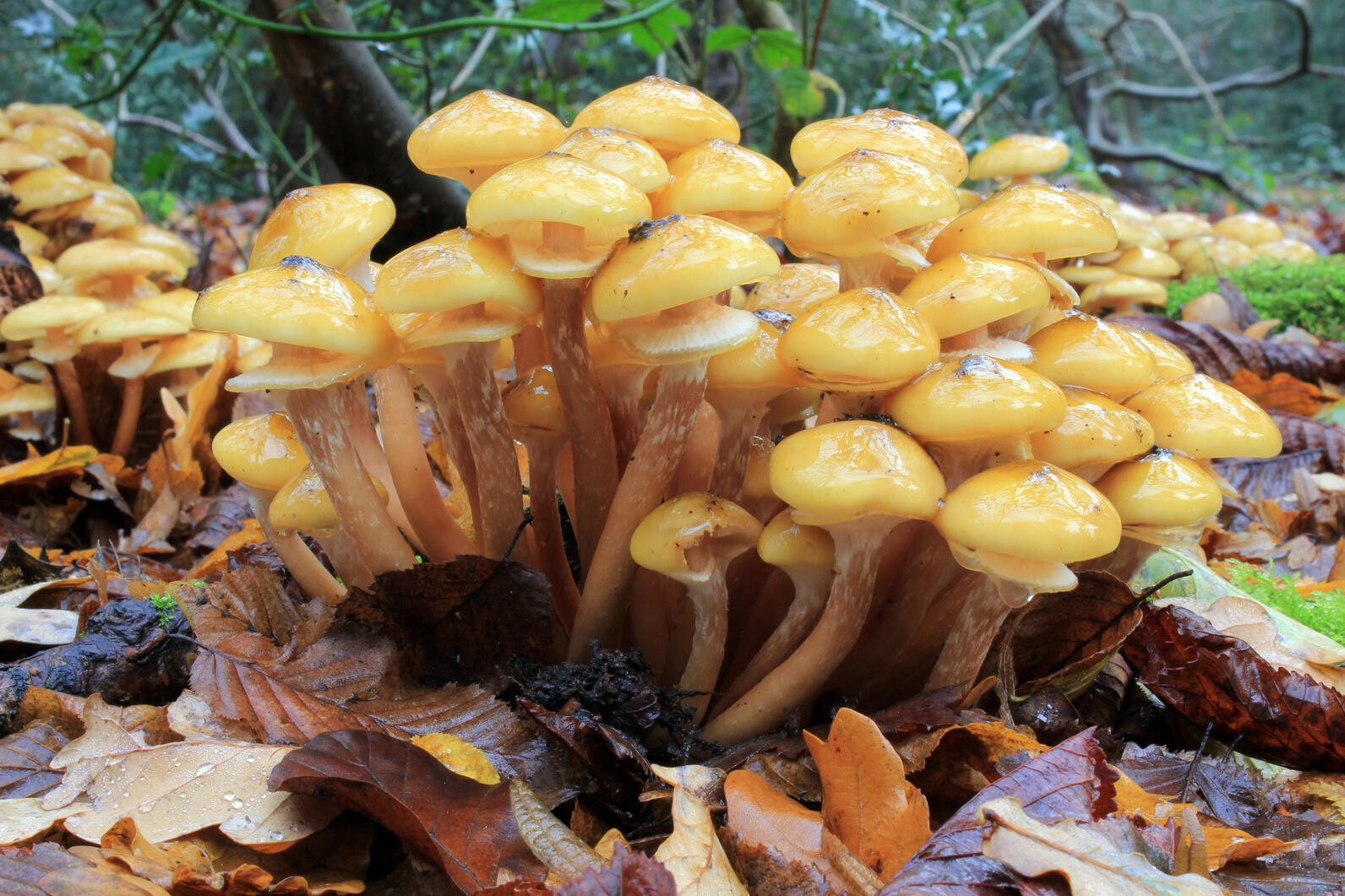As naturalists, we mostly focus on the things occurring above the ground, the things we can easily see or hear. However, there is a vast and wonderful world of creatures that live unseen beneath our feet. Underground, fungi exist within a vast network of roots and soil, the only evidence of them in the mushrooms they send above the surface and the constancy of decomposition and decay. That’s why I’ve chosen to focus on the humble but fantastic fungi that live all around us, whether we notice them or not.
While the fungi we encounter may look and act like plants, fungi are actually more closely related to us. Fungi, like animals, are heterotrophs that gain their nutrients from other living things, whereas plants are autotrophs that can produce their own food from photosynthesis. Fungi are made up of long hyphae — branching, thread-like structures that help fungi break down nutrients. Together, hyphae form a branching, tangled network of fungus called mycelium. Hyphae spread across a food substrate, for example, soil or dead plant matter, using chemicals to break it down into nutrients which are in turn absorbed by the growing fungus.
Fungi fill a variety of roles within an ecosystem. Some species of fungi help decompose dead organisms — you can often find this type of fungi on dead logs. These fungi, called saprotrophs, are especially important to the ecosystem as they aid in the process of nutrient cycling. You may have heard this type of fungi being called “decomposers,” since they’re responsible for breaking down dead organisms into nutrients that can be used by other organisms. In fact, saprotrophic fungi are responsible for decomposing almost all plant matter! If you’ve left food out for a long time, it may have had mold beginning to grow on it, which is a type of saprotrophic fungus.
Other species of fungi infect living organisms and cause harm, and sometimes even death, to them. These fungi are called necrotrophs, and they gain nutrients by killing the cells of their host plants. Many common diseases in garden plants, such as whitespot, blackspot, and canker are caused by necrotrophic fungi. Another example of a necrotrophic fungus is the infamous “zombie fungus” cordyceps, which attacks many species of insects and arthropods. Sometimes, however, fungi that gain their nutrients from other organisms don’t harm their hosts — these fungi are called biotrophs. Many species of biotrophic fungi even have a positive symbiotic relationship with their hosts, such as ectomycorrhizal fungi. Ectomycorrhizal fungi form a sheath of hyphae called the mantle around the roots of certain plant species, which allows the fungus and plant host to exchange beneficial nutrients. The fungi help the plants, typically woody plants like trees, access nitrogen from the soil, while the plants share some of their food with the fungi. It’s estimated that ectomycorrhizal fungi are responsible for providing their plant hosts with up to 86% of the nitrogen they need to survive! Ectomycorrhizal fungi make up several well-known culinary species of fungi, such as chanterelles and truffles, as well as common poisonous fungi such as amanitas and death caps.
A few times a year, fungi peek above the ground as mushrooms, complex fruiting bodies which shed spores and help fungi reproduce. Mushrooms come in a vast variety of shapes and sizes, from 7.5 millimeter frosty bonnet mushrooms to 35 foot-long polypores. Within the thread-like labyrinth of mycelium, young mushrooms begin as small nodules beneath the surface called primordia. After emerging, mushrooms distribute billions of minuscule spores through structures called gills. Spores are carried far away from their parents by the wind, and if they find a suitable environment, they will germinate and form new hyphae. When we think of mushrooms, we often think of a stalk topped by a cap. However, these fruiting bodies can take many different forms. Some of the more unique forms include bird’s nest fungi, which look like a cluster of bird’s eggs in a nest, polypores, which look like shelves dotting the side of a tree trunk, and puffball mushrooms, which, as the name suggests, look like giant puffballs emerging from the ground.
Here are some of our local fungi species to look out for:
California Golden Chanterelle (Cantharellus californicus): Also called “mud puppies” or “oak chanterelles,” the California Golden Chanterelle is endemic to the oak woodlands of California. Edible and delicious (the flavor is described as sweet and fruity), California Golden Chanterelles are popular with mushroom foragers in the San Francisco Bay Area. They are most common between November and April and can be found alongside tree species such as coast live oak, interior live oak, and tan oak. Recently, the California Golden Chanterelle was named as the official state mushroom of California.
Morels (G. Morchella): Another mushroom that’s popular with foragers, morels can be found between January and May. Although scientists are still working out species classifications for morels, many morel species live in Marin County. Check for landscape morels, Morchella rufobrunnea, among woodchips, compost heaps, yards, and gardens. Burn morels, comprised of several morel species including the Morchella esculenta, appear in coniferous woodlands after wildfires. As of now, it’s unclear whether the morels are simply taking advantage of recent wildfires or if they have a symbiotic relationship with burned coniferous trees, but there is some speculation that morels may help forest ecosystems recover from wildfires. Given the recent wildfires in California, many mushroom foragers found a silver lining to these grave, climate change-driven events: forests laden with tasty morel mushrooms.
Fairy Rings: This isn’t a species of mushroom, but rather an incredible natural phenomenon that carries a great deal of folklore and superstition. Fairy rings are formed when the center of the mycelium dies, leaving behind an underground ring of mycelium. When the fungus sends up mushrooms, they appear in an eerily perfect circle. For hundreds of years, many folktales warned against stepping inside a fairy ring; today, they remain a rare but incredible sight. A handful of species are known to form fairy rings, including local species such as Fly Agarics (Amanita muscaria), Death Caps (Amanita phalloides), and Scotch Bonnets (Marasmius oreades).
Western Jack-O-Lantern (Omphalotus olivascens): These saprotrophic mushrooms are endemic to California, Mexico, and Southern Oregon. You can find them growing on decomposing wood stumps, logs, and tree trunks. Western Jack-O-Lanterns often grow in clusters, are orange in color, and have deep gills. These poisonous mushrooms are sometimes mistaken for chanterelles, their edible look-alikes. However, while chanterelles have white flesh when cut open, Western Jack-O-Lanterns are orange all the way through. The most interesting thing about these local mushrooms, however, is their bioluminescence. The most impressive bioluminescent mushroom in the Bay Area, Western Jack-O-Lanterns are the brightest during peak spore production, when they are neither too old nor too young. Some even claim that their light is bright enough to read a newspaper with. You can find these incredible mushrooms shining in the night from late fall to mid-winter — perfect for Halloween.

Lion’s Mane (Hericium erinaceus): One of our odder-looking local mushrooms, Lion’s Mane mushrooms appear as a white, shaggy clump growing on the side of a tree — a texture that appears similar to a lion’s mane. Lion’s Manes are both saprotrophs and necrotrophs: they feed on dead trees and also act as parasites to dying or wounded trees. Due to their popularity in traditional medicine, and more recently as a mainstream dietary supplement and culinary ingredient, Lion’s Mane is commonly cultivated by humans. So far, medical studies have reported a variety of potential benefits from eating Lion’s Mane, including lowering inflammation, aiding nerve regeneration, preventing dementia and Alzheimer's, sharpening cognitive performance, enhancing mood, managing diabetes, and preventing stomach ulcers. They can be found growing on the trunks of coast live oak, interior live oak, canyon live oak, California black oak, valley oak, and blue oak during autumn and winter. Lion’s Manes are great mushrooms to look for if you’re just beginning to search for fungi: their ghostly white color is hard to miss amongst the browns of the forest.
Honey Fungus (G. Armillaria): Did you know that the largest organism on earth is a fungus? In Oregon’s Blue Mountains, a single subterranean Honey Fungus stretches across 2,384 acres, nearly 4 square miles, of land. While our local Honey Fungi are nowhere near as large, if you’re lucky, you may come across clusters of these small, honey-colored, bioluminescent mushrooms. Honey mushrooms appear near plants infected by the parent fungus. Honey Fungi cause a disease in plants called Armillaria root rot, which can be a nuisance for gardeners. You can find them in the autumn after the rain.

Amanitas: The genus Amanita hosts a variety of incredible fungi. Not only are amanitas beautiful, but they’re also dangerous — amanitas include some of the most poisonous mushrooms on earth and contain the species that is responsible for 95% of fatal mushroom poisonings. Look out for one of our incredible local amanitas, the Fly Agaric (Amanita muscaria). Admired for their beauty, Fly Agarics are classic red-with-white-spots mushrooms that can be found throughout the Northern Hemisphere. They’re described by Debbie Viess, cofounder of the Bay Area Mycological Society, as “eye-catching, neurotoxic, and the star of many a fairytale.” You can find these ectomycorrhizal fungi in deciduous and coniferous woodlands, primarily alongside pines, during wintertime. While some have reported eating specially prepared Fly Agarics, these whimsical beauties, like their relatives, are poisonous, and best admired at a distance. Another of our local amanitas to watch, or more accurately, watch out for, are Death Caps (Amanita phalloides), one of the most poisonous of all known mushrooms. These greenish-capped mushrooms were introduced to the West Coast from Europe in the 20th century and can be found in woodlands growing alongside coast live oak. Death Caps have high concentrations of amatoxins, which affect the liver and kidneys. Just half of one of these mushrooms is enough to kill an adult human, and some historians believe they’re responsible for the poisonings of the Roman Emperor Claudius and the Holy Roman Emperor Charles VI. Death Caps mistaken for edible mushrooms are responsible for the majority of mushroom poisonings, which is why it’s important to exercise caution and only eat foraged mushrooms identified by experts, who can be found through your local mycological society.
Whether we realize it or not, the lives of humans are tightly intertwined with the humble fungus. From providing medicine and maintaining ecosystems to inspiring fairytales, the important role of fungi in our lives cannot be understated. As you wander through the woods, take a moment to look down, for hiding amongst the earth, these treasures of the forest are waiting to be seen.




